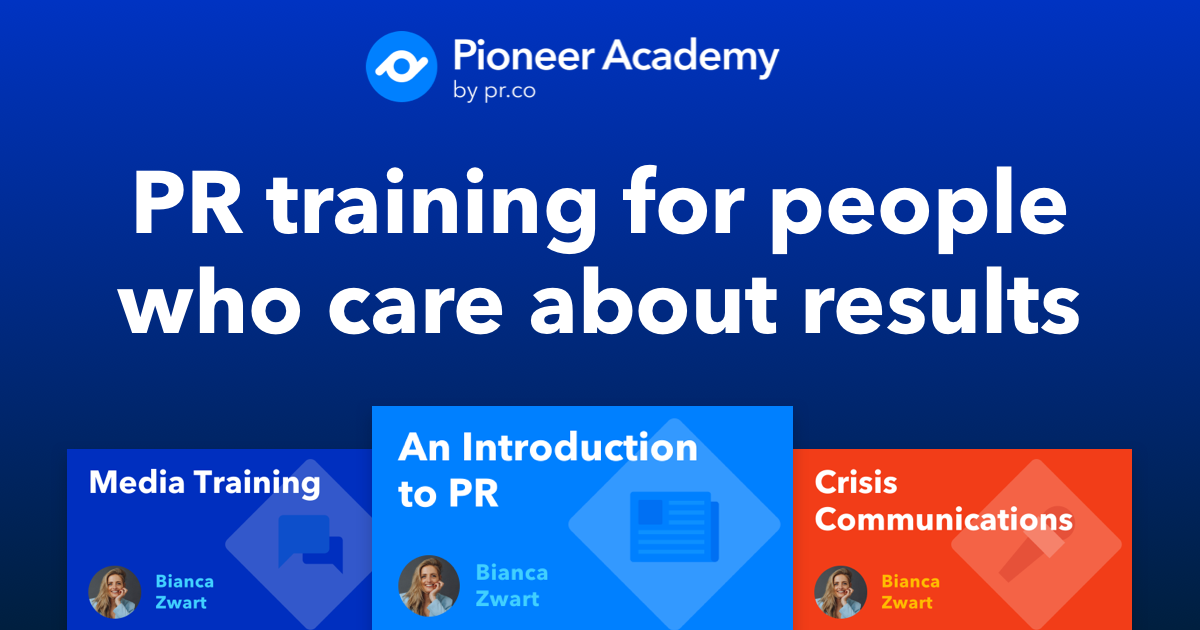Modern PR is about more than just creating buzz and goes well beyond what journalists deem newsworthy. It’s about building credibility and creating a brand audiences can trust by tapping into various online and offline tools and tactics.
Nowhere is establishing credibility more crucial than in the digital world, where rankings, visibility, and reputation can elevate—or undermine—even the most powerful brands.
In this guide, we explore the role of digital channels in modern PR strategy, distinguish between digital and traditional PR, examine the role of search engine optimization (SEO), and explore innovative digital PR tactics.
Sit tight—there’s a lot to cover.
Traditional PR vs Digital PR
Traditional PR leverages established media channels to build reputation, brand awareness, and reach among target audiences.
Typically, traditional PR teams working in this realm leverage the following channels to amplify brand messages:
- Print publications (newspapers, magazines, trade journals)
- Broadcast media (radio and television)
- In-person promotional events and press conferences
Traditional PR involves trying to reach a brand's audiences by building strong relationships with journalists, editors, and publications. By leveraging the reach of these traditional media, brands can reach their audiences.

Digital PR offers ways to have brands reach their various audiences without a dependency on traditional media or news outlets. It's about finding ways for brands to reach an audience directly through a brand's online presence. Digital PR expands this toolkit, with PR teams managing online reputation and online presence through for instance:
- SEO
- Multimedia content production: e.g., blogs, podcasts, videos, webinars
- Digital storytelling
- Strategic influencer partnerships
- Online media relations: the strategic management of communication between an organization and the people responsible for producing the news and features in the media
While both approaches share fundamental goals—engaging audiences and building relationships—digital PR efforts offer unprecedented agility.
For example, writing and publishing a post on social media is quick, and it’s easy to monitor engagement and respond to feedback. Sending out a newsletter or publishing an article on LinkedIn doesn’t require days of design or hogging a journalist with an overflowing inbox.
The responsiveness of digital media enables brands to address emerging challenges swiftly, capitalize on trending topics, and shape brand narratives in real time. Smart PR teams use this agility to grab target customers’ attention and kick dust in the eyes of their competitors.
9 steps to crafting a Digital PR Strategy
Creating an effective Digital PR strategy requires a blend of creative thinking and analytical skills. Here’s a streamlined approach to guide you through this process:
1. Define Your Objectives: Start by outlining clear goals that align with your overall business strategy. Whether it’s increasing brand awareness, enhancing online reputation, or driving website traffic, know what you want to achieve.
2. Identify Your Target Audience: Understand who your audience is. Create audience personas based on demographics, interests, and online behavior to tailor your messaging and outreach efforts effectively.
3. Select your Online Channels: PR professionals must carefully analyze their target audience to identify which online channels will be most effective for reaching them. By evaluating the strengths and weaknesses of each platform, they can prioritize those that align with their campaign objectives and audience preferences.
4. Leverage SEO: Incorporate a strong SEO plan into your PR efforts. Research relevant keywords and phrases to enhance your content’s visibility and ensure that it reaches the right audience through search engines.
5. Develop Compelling Content: Create engaging, high-quality content that resonates with your audience. Use various formats—blogs, infographics, videos, and podcasts—to communicate your brand story effectively.
6. Engage with Influencers: Build relationships with industry influencers and thought leaders who align with your brand. Collaborate on campaigns to expand your reach and credibility within your target market.
7. Utilize Social Media: Choose the right platforms to connect with your audience. Share your content, engage in conversations, and respond to queries promptly to foster a community around your brand.
8. Monitor and Analyze Performance: Use analytics tools to track the success of your Digital PR efforts. Measure key performance indicators (KPIs) such as website traffic, social media engagement, and media coverage to ensure you’re on the right track.
9. Adjust and Optimize: Based on analysis, continually refine your strategy. Stay flexible and adapt to trends, audience feedback, and changing market dynamics to keep your Digital PR efforts effective.
By following these steps, you’ll be well on your way to building a robust Digital PR strategy that not only amplifies your brand's voice but also engages your audience effectively.
How to Set Clear Digital PR Objectives
Successful digital PR strategies begin with well-defined goals. These should be closely aligned with broader business and marketing objectives.
Common digital PR objectives include:
- Enhancing search engine visibility
- Increasing qualified website traffic
- Building high-quality backlink portfolios
- Generating qualified leads
- Establishing industry thought leadership
- Expanding brand awareness
- Promoting specific products, services, or corporate values
PR objectives should be Specific, Measurable, Achievable, Relevant, and Time-bound (SMART), thus laying the foundation for a good strategy.
Here are two examples of what SMART goals look like:
- Example 1: Generate 50 earned media placements in top-tier tech publications like TechCrunch, Wired, and The Verge by Q4 2025, with 30% featuring executive quotes.
- Example 2: Secure partnerships with 10 industry influencers (each with more than 100K followers) to create monthly content, reaching 1M+ combined followers by July 2025.
Our guide to setting up and measuring PR goals covers the details, but one of the most important elements of your digital PR strategy is matching your goals to trackable metrics or KPIs. For example, if you’re running PR for a fast-growing company that wants to extend its reach, you can focus on KPIs like share of voice, impressions, and geographic reach. On the other hand, measuring sentiment might be more helpful if you’re trying to track whether you’re building lasting relationships with customers.
Defining your audience and selecting online channels
To effectively reach your audience, PR professionals must start by defining them with precision. This process involves gathering data on demographics, interests, behaviors, and geographic locations. Utilizing surveys, social media analytics, and customer feedback can provide invaluable insights into who your audience is and what resonates with them. Segmenting your audience into distinct groups allows for more personalized communication, enabling your PR strategies to be tailored to each segment's preferences and pain points. Remember, understanding not just who your audience is but what they value will inform all subsequent PR efforts.
Once your audience is clearly defined, the next step is to identify the online channels where they are most active. Begin by analyzing which platforms align best with your audience's demographics and interests. For instance, younger audiences may gravitate towards platforms like TikTok or Instagram, while professionals might prefer LinkedIn. Additionally, consider where your audience engages with content most frequently—this could be blogs, podcasts, social media, online platforms, or community groups. Using tools such as Google Analytics and social media insights can further help determine where your outreach will be most effective. By focusing on the right channels, you can optimize your PR campaigns to maximize engagement and build trust with your target audience.
.jpg?width=1180&height=1770&name=s-o-c-i-a-l-c-u-t-8IhR5aunsko-unsplash%20(1).jpg)
Don't forget: build an OWNED online channel
Creating and maintaining your own online channel is a fundamental element of a successful digital PR strategy. Owning digital real estate—such as an online newsroom, blog, or dedicated content hub—enables you to publish a diverse range of content formats, including press releases, blog posts, guest posts, case studies, and interactive content. This variety not only enhances your digital presence but also fosters positive media coverage, as journalists and influencers are more likely to reference and share content that originates from a reputable source. By establishing a centralized platform, you strengthen your narrative, allowing you to effectively communicate your brand’s message while building credibility in your industry.

Moreover, leveraging your owned online channel aligns perfectly with the principles of inbound marketing, transforming it into inbound PR. By consistently producing high-quality content that meets the needs and interests of your audience, you can attract them organically, driving traffic and engagement without relying solely on paid advertising. Formats such as video interviews for Investor Relations, informative articles, and engaging infographics can appeal to a wider audience, establishing your authority and nurturing relationships with stakeholders. As your content gains traction, it enhances your Domain Rating, improving your visibility on search engines. This increased exposure allows you to share your insights across various digital platforms and incentivize visitors to subscribe for updates, ensuring your audience is always informed and engaged on their terms.
Ultimately, by investing in your owned online channel, you create a robust foundation for your digital PR campaigns. This not only amplifies your brand's reach but also enables you to control the narrative and build lasting relationships with your audience. In today's fast-paced digital landscape, owning your content delivery mechanism is not just an option—it's a necessity.
How can PR pros leverage SEO?
SEO and PR are intricately linked in a world that can no longer function without Google Search.
What makes digital PR so powerful is the fact that it doesn't just drive online visibility for your news stories: it boosts all your online efforts. All SEO efforts in your digital PR strategy, will instantly increase visibility for all other owned, online channels as well. So your digital PR content will boost all other digital marketing efforts — your content marketing colleagues will be thankful. SEO is a broad term that includes technical elements like site speed, metadata optimization, and mobile responsiveness to optimize a website's domain authority and search ranking. However, it also involves content-focused components like keyword research, keyword implementation, and link building (when one webpage links to another).
Optimizing content to improve visibility in search results and building authoritative backlinks to drive website traffic form part of the digital PR professional’s to-do list. In most instances, content optimization is done with the help of marketing and content teams.
Digital PR teams also work hard to build brand reputation, handle media relations through online newsrooms or press pages, and create compelling narratives across various brand touchpoints (e.g., events, thought leadership articles, newsletters, and social media campaigns).
How to reach more people through SEO?
In today's digital landscape, PR professionals can significantly enhance their outreach by integrating SEO strategies into their campaigns. So, how can you reach more people through SEO? The key lies in creating relevant content that resonates with your target audience, making sure that it addresses their needs and interests. By focusing on keywords with high search volume, you can position your content to align with what potential customers are actively searching for online.
Additionally, producing high-quality content not only helps engage your audience but also improves your SEO rankings. Search engines favor high-quality content, which can lead to increased organic traffic as users find your material valuable. This drives online mentions and builds your credibility across authoritative websites, further enhancing your brand’s visibility.
Moreover, securing high-quality links from reputable sites will boost your search engine ranking. Links act as endorsements for your content, signaling to search engines that your information is trustworthy. As your content gains traction through these links, it can attract even more potential customers, amplifying your overall digital PR efforts. By leveraging these techniques, PR pros can effectively reach a wider audience while establishing their brand as a thought leader.
How to Create Compelling Digital PR Content
Innovative Digital PR Tactics
We’ve touched on SEO and will later discuss social media—two key elements of digital Public Relations. However, these elements must dovetail with other tactics and strategies to drive PR success.
Today’s top PR professionals also employ approaches such as:
1. Strategic newsjackingThis involves capitalizing on trending stories while ensuring relevance and timing.
For example, when Meta announced significant changes to their privacy policies, several cybersecurity companies successfully positioned themselves as expert commentators, gaining valuable media coverage and establishing authority.
Another example is Samsung’s response to an Apple ad gone wrong. Apple’s failed “Crush” ad, which showed musical instruments and art materials being crushed, drew backlash from their audience of creatives. Samsung quickly capitalized on the negative press by releasing an ad emphasizing the brand’s commitment to creativity.
2. Creative campaign strategiesAnother way to engage and mobilize audiences is using creative campaign strategies, like experiential online events or running hashtag challenges (that hopefully go viral).
Not every tactic will work for every brand, so think carefully about the brand values and what you’re hoping to achieve, using 2024’s list of the best PR campaigns for inspiration.
Consider developing unique, engaging campaigns through:
- Interactive online events
- Virtual reality experiences
- User-generated content challenges
- Cross-platform storytelling initiatives
Advanced analytics and AI technologies have given digital PR teams unprecedented access to consumer insights and market intelligence. As a result, data-driven storytelling—the art of using data insights to deliver highly targeted messaging and narratives—is gaining momentum.
Through data, brands create highly shareable content — this could either be stories that are highly personalized through data, or data-driven stories that can be used to create a source for new blog posts.

A great example is Spotify’s popular “Wrapped” feature, which summarizes each user’s year in music. Other major platforms like Nintendo and Instagram have adopted similar data-driven storytelling approaches to engage users.
Other ways of using data to create compelling narratives include:
- Creating data-rich industry trend reports
- Developing data-backed thought leadership pieces
- Sharing meaningful insights through infographics and interactive visualizations
Building Valuable Partnerships Through Influencer Outreach
Influencer outreach and partnerships are nothing new, but oh so important. The right partner can make or break your brand, particularly when these influencers authentically share their endorsements with audiences that align with your niche. Identifying key influencers who not only possess a substantial following but also influence their audience's purchasing behavior is vital; their perceived credibility determines the power of your partnership.
When cyclists think of Canyon, they think of Matthieu van der Poel. When F1 fans think of Red Bull, they think of Max Verstappen. When hip-hop fans think of Adidas, they’ll think of Kany... oh wait.
You see: the right partnership can make or break your brand.
Maximizing Impact Using Social Media
Social media platforms like Facebook, TikTok, LinkedIn, and Instagram are powerful digital PR channels allowing brands to engage their audiences directly.
Notably, these platforms are starting to play the role of search engines like Google Search. A growing number of people are turning to find brands, get real-time updates on products, and seek out reviews from others via social media, notes Kimberlee Meier for Sprout Social.
“Social media search also offers something traditional search engines don’t—a place to follow influencers, seek out industry experts, and scroll through niche content tailored to your interests.”
Forbes research shows a decline of 25%, on average, between Generation Z and Generation X in using Google to search.
In 2025, brands no longer have an option: They must be present on the social platforms their target audiences frequent.
There are two important first steps for PR professionals:
Step 1: Platform selection and optimization
Not all social platforms are created equal, and not every social channel will fit every PR strategy.
Choosing platforms that align with the brand and its target audience is critical. For example:
- LinkedIn is ideal for B2B companies, professional services, and thought leadership. It’s also the perfect medium for employee influencers to amplify their B2B brands’ messages.
- Instagram is perfect for visually-driven brands and lifestyle companies.
- TikTok is excellent for reaching younger demographics and creative industries.
From time to time, it’s worth reassessing which platforms to use. New platforms emerge, and others change and may no longer suit a particular brand (think of Twitter’s recent transformation to X).
Note that Facebook remains the world’s largest social network, with over 3 billion monthly active users.
Step 2: Authentic engagement
Social media is one of the best tools for building relationships with target audiences—if the brand posts content that sparks conversations and authentically engages target customers. Doing so builds trust and loyalty, increasing the chances of converting customers into brand advocates.
In 2025, it’s best to build meaningful relationships through:
- Consistent, high-value social media content that’s newsworthy or entertains/educates
- Regular audience interaction
- Timely responses to comments and messages
- Transparent communication during crises
- Strategic influencer collaborations that align with brand values
Step 3: Monitor your social channels and online reputation
Pick the right monitoring and analytics tools
Dedicated measurement platforms can help your PR and marketing teams consolidate and analyze their performance data. Researching and choosing tools that best support your goals is important. You can, for example, tap into:
- Media monitoring tools like Mention.com
- SEO analysis tools like AHRefs, Semrush and Frase.io
- Social listening solutions to track social mentions of your brand like Hootsuite
- Content tracking tools like Hubspot
- Online reputation management tools like Determ
- Analytics tools like Google Analytics
- Sentiment analysis programs like Meltwater of OBI4wan
Note that there are many, many options available. We have reviewed a list of tools in our PR and communication tool guide — which can surely help you to determine your ideal tech stack.
Some of these tools cost a pretty penny. If you're building a digital PR strategy on a budget, you might want to look into creative, cost-effective ways to build your tool stack. Especially with the rise of AI, it's getting increasingly easier to build a powerful software stack without going bankrupt.
Pro Tip: Creating a Cost-Effective Monitoring System Using ChatGPT
We recently published an article highlighting 10 ways PR pros can leverage AI. Here we also outline a nifty way of building a very cost-effective monitoring system using ChatGPT, Zapier and Google Alerts — have a look.
Why Digital PR should collaborate with marketing
Every brand’s PR and marketing teams should amplify each other’s efforts to drive strong campaigns across various audience touchpoints.
These teams’ responsibilities overlap in many ways. Both teams handle online content and distribution across channels, brand messaging and storytelling, social media management, crisis communications, and campaign effectiveness measurement.
The key difference is that PR typically focuses on owned media, earned media, and reputation management, while marketing emphasizes paid media and direct revenue generation.
These two teams can build strong connections—and effective campaigns—through:
- Regular cross-team meetings
- Shared content calendars
- Collaborative campaign planning
- Unified measurement frameworks
- Integrated storytelling approaches
- SEO strategies
As discussed earlier in this article, it's important to understand that digital efforts, no matter whether they're PR or marketing, will lead to synergy. By publishing your PR content online, you build your Domain Authority, and therefore make all content on that domain better findable — that includes your website and blog.
Successful Digital PR Examples
To illustrate the power of modern digital PR, let’s look at two successful campaigns.
Real Beauty: Dove’s Real Beauty campaign started in 2004 when research revealed that only 2% of women consider themselves beautiful. The beauty brand created a clever PR campaign emphasizing real women with real bodies, challenging unrealistic beauty standards.
Even though the campaign started with a real-life scientific study, Dove spun their initial campaign success into a series of digital triumphs. This included their impactful “Reverse Selfie” campaign, which exposed how young people digitally alter their social media photos.
Why it works: Dove combined data-driven research, positive audience engagement, and a commitment to an important social issue (which most women can relate to) to deliver a strong campaign. Then, they doubled down on their messaging by making realistic beauty a core part of their brand identity. Masterful.
Pizza Perfect: One of the freshest takes on digital PR is Pizzelo’s “Best Cities for Pizza” campaign, which used review data, a research study on the 250 best cities in America for pizza, and media engagement to generate buzz and build brand awareness.
The campaign generated widespread social media buzz and traditional media coverage, as journalists nationwide reported on their cities’ pizza rankings.
Why it works: Pizzelo’s clever use of data to engage audiences across the United States is a great example of how to start a conversation with your audience at scale. Add the attention the study got from journalists at mainstream media outlets, and you have the perfect strategy for generating authoritative backlinks and reaching new customers.
Future Trends in Digital PR
Considering how quickly the PR landscape has changed over the past two decades, it’s safe to say we’re in for a helluva ride over the next few years, especially as AI use explodes.
In 2025, the digital PR landscape will continue to evolve with:
- AI-powered content optimization and distribution;
- Enhanced personalization through the smart use of data;
- Virtual and augmented reality (VR/AR) experiences;
- Voice search optimization;
- Renewed interest in paid media;
- And much more.
While embracing new technologies and tapping into trends is important, successful digital PR teams focus on creating authentic connections with target customers.
Creativity, fresh thinking, and high-quality campaigns set the best PR teams—and the brands they support—apart.
The Perfect PR Partner
Digital PR has evolved from a nice-to-have into a critical business function. Combining traditional PR principles with digital innovation can build strong brands, engage audiences more effectively, and achieve measurable results for businesses operating in a highly competitive environment.
We build sites and PR software that deliver results, for some of the biggest brands in the world. We stay laser-focused on the tech so you can launch ambitious PR campaigns without breaking a sweat.
Keen to learn more? Get in touch.
Sjors Mahler is the Commercial Director at pr.co. He’s worked with PR and communications teams for 9 years and has organized dozens of meetups and events for the Amsterdam PR community. Sjors has an MSc in Persuasive Communications and specializes in branding, sales strategy, and inbound PR.. Connect on LinkedIn or send an email






